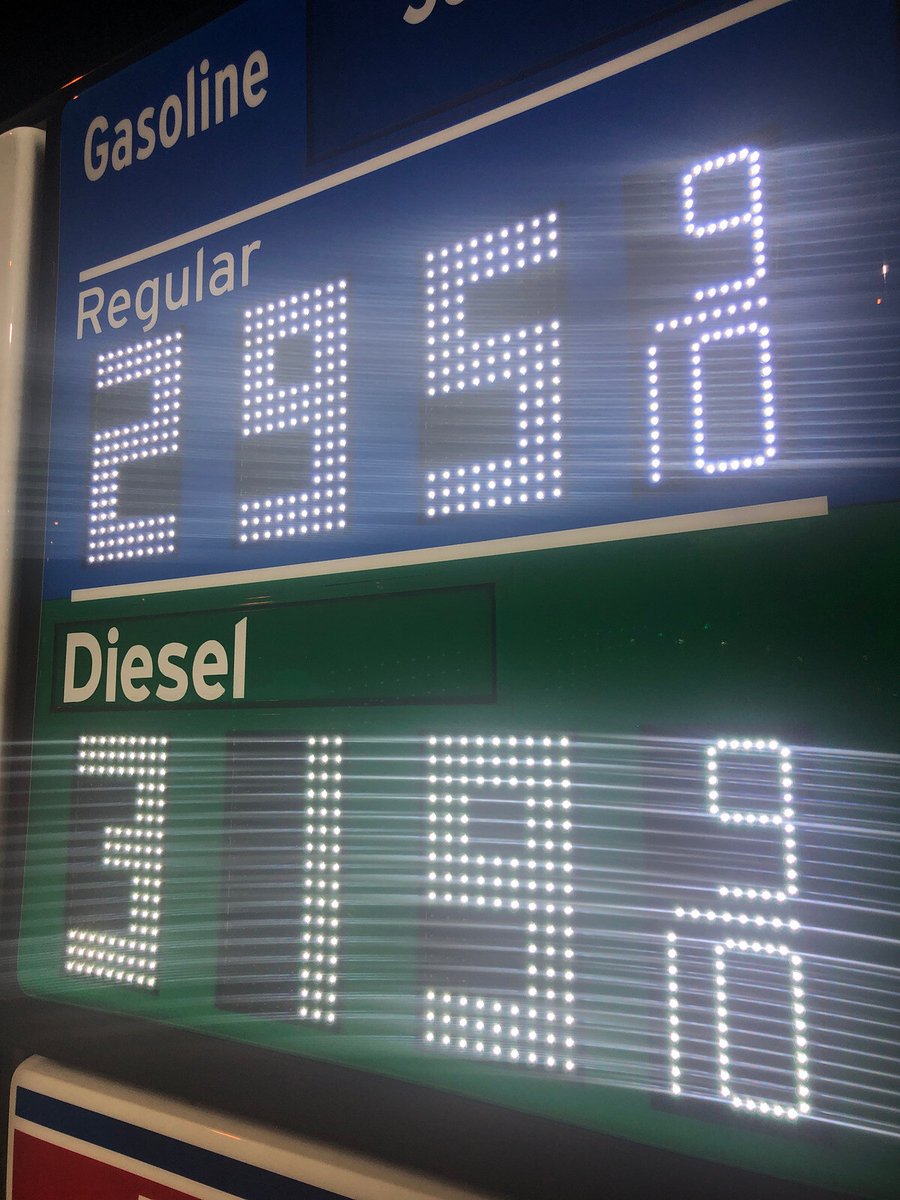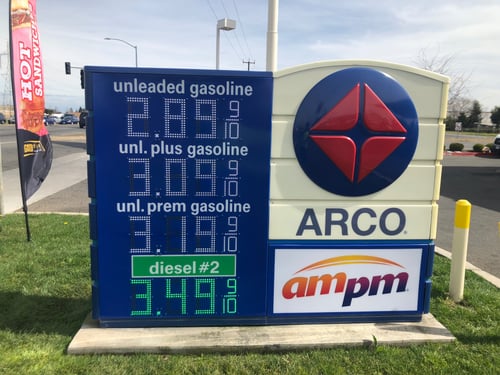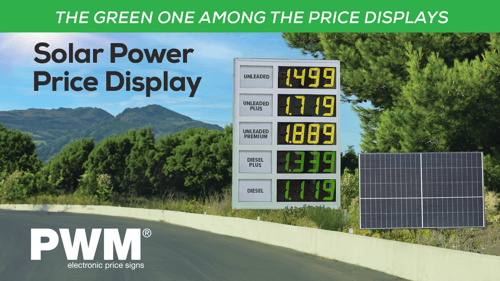4 min read

Benjamin Franklin helped popularize the aphorism “time is money” almost 300 years ago but the phrase rings true today for gas station and convenience store (c-store) operators.
Every minute truly counts as downtime can significantly impact your bottom line, customer satisfaction, and overall operational efficiency.
One often overlooked area where improvements can make a substantial difference is your price signage.
Traditional manual price signs are not only time-consuming to update but also prone to errors and breakdowns. Enter digital price signs–a game-changing solution that can revolutionize your operations and minimize downtime.
Let’s look at the time savings digital signs offer by reducing the need for manual adjustments and other advantages that translate into improved operational efficiency for gas stations and c-stores.
The Hidden Costs of Manual Price Signs
For those still firmly in the “if it ain’t broke, don’t fix it” camp, they need to examine the hidden costs of manual price signs.
While upgrading to digital price signs comes with a cost, there are hidden costs associated with traditional manual signage:
- Time-consuming updates: Staff must physically change prices, often multiple times a day. This process can take anywhere from 15 to 30 minutes per sign, depending on the size and complexity. For a station with multiple signs, this can amount to several hours of labor each week dedicated solely to price changes.
- Safety concerns: Employees may need to use ladders or lifts to reach high signs, increasing the risk of falls and injuries. According to the Bureau of Labor Statistics, falls from ladders account for approximately 20 percent of all occupational fatal fall injuries. This risk exposure can lead to higher insurance premiums and potential worker's compensation claims.
- Weather-related issues: Rain, snow, or extreme temperatures can delay price changes, sometimes for hours or even days. This can result in outdated pricing, potentially leading to lost revenue or customer dissatisfaction. In severe weather, manual price changes may be impossible, leaving your station at a competitive disadvantage.
- Human error: Mistakes in pricing can lead to customer complaints and lost revenue. Studies show that manual data entry has an average error rate of 1 percent, which may seem small but can translate to significant losses over time. For a gas station selling thousands of gallons per day, even a small pricing error can result in substantial financial impact.
- Maintenance headaches: Broken letters, burnt-out bulbs, and wear-and-tear require frequent repairs. These issues not only involve direct repair costs but also result in periods where pricing information is incomplete or illegible. On average, manual signs may require maintenance every 3-6 months, with each repair potentially costing hundreds of dollars in parts and labor.
These factors contribute to increased downtime, reduced efficiency, and potential loss of customers who may choose a competitor with more up-to-date and clearly displayed pricing.
The Digital Advantage: Streamlining Operations
Digital price signs offer a multitude of benefits that directly address the challenges posed by manual signage and significantly improve operational efficiency:
- Real-Time Data Monitoring and Instant Updates: With digital price signs, you can update prices and monitor performance in real-time:
- Update prices instantly from a central location, responding quickly to market fluctuations.
- Enables dynamic pricing based on competitor pricing, demand, time of day, and fuel cost changes.
- Display critical data such as fuel inventory levels or car wash queue times.
- Identify potential issues before they escalate, minimizing costly downtime.
- Ensure consistency across multiple locations with the push of a button.
- KPI Tracking and Improved Accuracy: Digital signs eliminate the risk of human error and allow for easy tracking of key performance indicators:
- No more misplaced or upside-down numbers.
- Automatic synchronization between the point-of-sale system and displayed prices.
- Display and track KPIs like fuel sales volume, in-store promotion effectiveness, or customer wait times.
- Encourage staff to meet targets by making performance metrics visible.
- Enhanced Safety and Streamlined Maintenance: By removing the need for manual changes and integrating with IoT systems, digital signs improve workplace safety and maintenance processes:
- Eliminate the risk of falls from ladders or lifts during price changes.
- Display scheduled maintenance updates to ensure timely repairs without interrupting operations.
- Predict potential equipment failures, allowing for preventive maintenance.
- Reduce liability and potential worker's compensation claims.
- Weather-Resistant Technology: Modern digital price signs are built to withstand various weather conditions:
- High visibility in bright sunlight or nighttime conditions.
- Waterproof and dust-resistant designs.
- Operational in extreme temperatures, ensuring consistent display.
- Remote Monitoring, Diagnostics, and Automated Alerts: Advanced digital sign systems offer remote monitoring capabilities and automated alerts:
- Detect and diagnose issues before they become major problems.
- Receive instant alerts for any malfunctions, discrepancies, or when performance metrics fall below acceptable levels.
- Perform software updates and maintenance remotely.
- Reduce downtime caused by human error through timely, automated notifications.
- Clear Communication and Shift Management: Digital signs facilitate effective communication across shifts and departments:
- Display current fuel prices, promotions, and operational statuses.
- Ensure smooth transition between shifts by providing clear, up-to-date information.
- Reduce downtime caused by miscommunication or workers waiting for instructions.
- Keep all staff informed about safety protocols and urgent updates.
Digital Price Signs are Cost Effective with Less Maintenance Required
While there's an initial investment, digital signs often have lower long-term costs compared to manual signs. They require less maintenance, reduce labor costs for price changes, and can increase sales through effective marketing.
When comparing digital price signs to traditional signs in terms of maintenance costs, there are several important factors to consider:
Maintenance Costs for Traditional Signs:
- Require manual updates, which can be time-consuming and labor-intensive.
- May need frequent repainting or repairs due to weather exposure and wear and tear.
- Replacement costs when signs become outdated or damaged.
- Generally lower ongoing costs, but expenses can add up over time with frequent changes.
Maintenance Costs for Digital Price Signs:
- Higher upfront costs for equipment and installation.
- May require occasional repairs or replacements of electronic components.
- Significantly lower costs for content updates, which can be done remotely and instantly.
- Reduced labor costs associated with manual price changes.
- Potential for lower long-term maintenance costs due to durability of modern digital displays.
Key Advantages of Digital Signs for Maintenance:
- Remote monitoring and diagnostics capabilities reduce on-site maintenance needs.
- Automated alerts can prevent major issues and minimize downtime.
- Software updates can often be performed remotely, reducing maintenance visits.
- Greater durability in various weather conditions compared to some traditional signage.
For many operations, especially those with frequent price updates or multiple locations, the long-term savings and operational efficiencies of digital signs can outweigh the higher upfront investment.
Embracing the Future of Price Signage with PWM
In today's competitive market, gas stations and c-stores cannot afford the inefficiencies and downtime associated with traditional price signs.
Digital price signs, such as those manufactured by PWM, offer a robust solution that not only improves operational efficiency but also enhances customer experience and opens new avenues for marketing and promotion.
PWM’s innovative TRACK technology is a comprehensive system that offers:
- Real-time communication between your headquarters and each price sign.
- Automated price reporting with timestamps.
- System diagnostics down to individual SMD LEDs.
- Integration with point-of-sale interfaces.
- Secure cloud connection for data transmission.
With TRACK, gas station and c-store operators can:
- Monitor sign performance in real-time.
- Receive instant alerts for any issues.
- Perform preventative maintenance to reduce downtime.
- Manage multiple locations from a single, user-friendly interface.
By choosing PWM's digital price signs with TRACK technology, you're not just updating your signage – you're investing in a system that will drive your business forward, reduce downtime, and give you a competitive edge in the market.
Contact PWM today to discover how our cutting-edge digital price sign solutions can improve your operational efficiency.
Featured Articles
Beyond Gas: How Signage Powers EV and Retail Growth
12 Nov, 2025
Subscribe to Our Blog
Related Articles
Houston, TX (May 24, 2023) - PWM, the global leader in electronic price signs and profit boards® for convenience stores, is proud to announc...
The classic PWM electronic price sign system can now run on green energy. Solar Power Price Display is the first PWM segment display operate...
Consumers are keeping a wary eye on their pocketbooks with the possibility of a looming recession which makes PWM’s new pump toppers importa...






